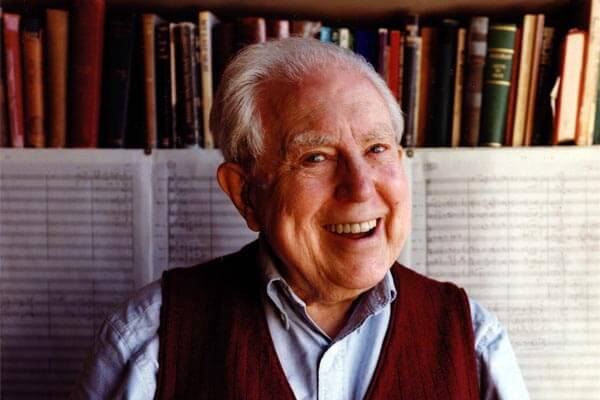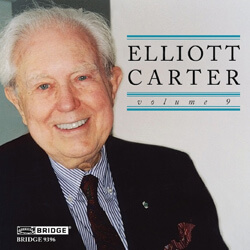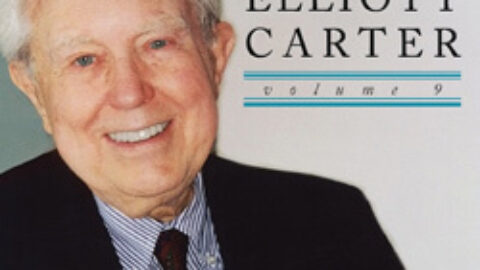 The programming on this, the ninth volume in Bridge’s long-running Elliott Carter Edition, is unexpectedly cunning. On the surface of things, it looks like little more than a grab bag – mostly leftovers. The contents: three concise early songs, a new recording of one of the more knotty, intractable works of Carter’s maturity, and a clutch of small-scale pieces from the latter half of the previous decade. Maybe it was simply a case of making lemons into lemonade, but Bridge’s decision to sequence these odds and ends in strict chronological order isn’t the least of the disc’s attractions. If placing the charming but essentially self-effacing vocal miniatures before the imposing barbed-wire edifices of the Piano Concerto makes it clear that Carter could never have found a comfortable niche in the midcentury symphonic mainstream, hearing the sublime invention of the late miniatures cheek by jowl with one of the composer’s most “difficult,” studied scores suggests that Carter’s mature musical language could accommodate as many moods and forms as any since Stravinsky.
The programming on this, the ninth volume in Bridge’s long-running Elliott Carter Edition, is unexpectedly cunning. On the surface of things, it looks like little more than a grab bag – mostly leftovers. The contents: three concise early songs, a new recording of one of the more knotty, intractable works of Carter’s maturity, and a clutch of small-scale pieces from the latter half of the previous decade. Maybe it was simply a case of making lemons into lemonade, but Bridge’s decision to sequence these odds and ends in strict chronological order isn’t the least of the disc’s attractions. If placing the charming but essentially self-effacing vocal miniatures before the imposing barbed-wire edifices of the Piano Concerto makes it clear that Carter could never have found a comfortable niche in the midcentury symphonic mainstream, hearing the sublime invention of the late miniatures cheek by jowl with one of the composer’s most “difficult,” studied scores suggests that Carter’s mature musical language could accommodate as many moods and forms as any since Stravinsky.

As heard here in a 1976 archival recording featuring Bridge co-founder David Starobin’s stylish guitar accompaniment, the very early Tell Me Where Is Fancy Bred (1938) functions like a preamble or editor’s preface. As one of the composer’s few bona fide neo-classical works, its calculated faux-early music ambiance suggests that the young Carter was far more susceptible to the pressures of fashion than we now assume. By contrast, Warble for Lilac Time and Voyage (1943) paint a rather more ambivalent portrait of the youthful composer. While in Warble Whitman’s nature imagery occasions a supple, winning slice of open-air musical Americana, in Voyage Carter seems utterly at sea, unable to do justice to Hart Crane’s visionary, Orphic verses. Though the harmonic language occasionally shows signs of breaking the bonds of Copland-inspired pan-tonality, there’s not much the early Carter can do with lines like “Infinite consanguinity it bears / This tendered theme of you that light / Retrieves from sea plains where the sky / Resigns a breast that every wave enthrones.” It’s telling that Carter would only return to Crane in the Symphony of Three Orchestras of 1976, by which point his experiments with multiple temporal and intervallic strata were being put directly in the service of his expressive aims, which always retained a feeling for Ivesian fantasy and grandeur.
Carter hadn’t quite reached this point when he wrote the Piano Concerto (1964-5). Of course, with the first two String Quartets, the orchestral Variations, and the Double Concerto behind him, the added-note consonances of Voyage were now a distant memory. Instead, the Piano Concerto quickly acquired a reputation as one of Carter’s most impenetrable creations; it’s also one of his most misunderstood. (Alex Ross’ suggestion that the Concerto represents an assimilation of Jackson Pollock’s action painting technique is emblematic.) No doubt the result is a take-no-prisoners sort of listening experience, one frequently likened to Lutosławski’s Cello Concerto as an evocation of Cold War angst. The music is difficult to listen to in terms of pitch; one defaults to hearing the work’s convulsive gestures as a series of discursive choreographic actions, like a play rendered musically. Yet not all here is violence and darkness, for in the right hands the Concerto can yield a hidden current of sensuality and lyricism. Take the work’s opening, where the woodwinds Carter asks to be seated around the soloist gradually sneak in, delicately inflecting the piano’s resonance. Or there are the pianist’s second movement interior monologues, which the concertino strings and winds try to imitate, against the orchestra’s strenuous objections. These are qualities emphasized in the late Charles Rosen’s thoughtful performance with the Basel Sinfonietta, as distinct from Ursula Oppens’ more angular, straightforward reference recording as Rubinstein was from Horowitz. As David Schiff has noted, Rosen always elected to play the Concerto at slightly slower tempi than indicated. This lets a bit of air into the proceedings, subtly leavening the oppressive atmosphere, and the end result is a minute longer than Oppens (though still a full three minutes shorter than Jacob Lateiner’s clotted world premiere account). Rosen’s performance isn’t likely to convert anyone who has trouble with middle-period Carter, but taken on its own terms this sensitive new recording is an important document. In catching all of the Concerto’s impetuous humors while respecting its Byzantine architectural layout, Rosen’s more amiable account seems tailor-made for the nonagenarian Carter, who was mellower and less inclined to resort to justifications of complexity.
 Certainly Bridge’s sequencing – placing the late piano pieces directly after the Concerto – plays no small part in fostering this impression. The remarkably lucid Two Thoughts About the Piano (2005-06) and Tri-Tribute (2007-08) may be mere scraps from the artist’s workbench, but they’re no less extraordinary for that. The diptych Two Thoughts is the longer of the pair, with Intermittences, a study of the polarity between resonance and attack, being followed by Caténaires, a breathless, frisky toccata. As for Tri-Tribute, here we have three glittering gemstones, light as a feather with nary a note out of place. Once again, the performer, here Steven Beck, has to contend with Oppens’ standard; though he lacks some of Oppens’ whimsy, Beck is admirably precise. Finally, just as the proceedings began with a prologue, so the disc concludes with an postscript of sorts in the guise of Carter’s compact wind quintet Nine by Five (2009). Even at 100, Carter’s gift for instrumental characterization never flagged, his imagination running riot with the quintet’s “extended” palette (including piccolo, English horn, E-flat clarinet, and contrabassoon). From unusually rich chordal writing to snatches of “retro”-pointillism, Nine by Five has it all. It needs to be in the repertoire of all adventurous wind quintets, presto.
Certainly Bridge’s sequencing – placing the late piano pieces directly after the Concerto – plays no small part in fostering this impression. The remarkably lucid Two Thoughts About the Piano (2005-06) and Tri-Tribute (2007-08) may be mere scraps from the artist’s workbench, but they’re no less extraordinary for that. The diptych Two Thoughts is the longer of the pair, with Intermittences, a study of the polarity between resonance and attack, being followed by Caténaires, a breathless, frisky toccata. As for Tri-Tribute, here we have three glittering gemstones, light as a feather with nary a note out of place. Once again, the performer, here Steven Beck, has to contend with Oppens’ standard; though he lacks some of Oppens’ whimsy, Beck is admirably precise. Finally, just as the proceedings began with a prologue, so the disc concludes with an postscript of sorts in the guise of Carter’s compact wind quintet Nine by Five (2009). Even at 100, Carter’s gift for instrumental characterization never flagged, his imagination running riot with the quintet’s “extended” palette (including piccolo, English horn, E-flat clarinet, and contrabassoon). From unusually rich chordal writing to snatches of “retro”-pointillism, Nine by Five has it all. It needs to be in the repertoire of all adventurous wind quintets, presto.
Now that the composer has passed, it’s also worth reflecting on Bridge’s twenty-year-old Carter Edition. Whatever one thinks of Carter’s music, there’s no denying his status as “one of America’s most distinguished creative artists,” as Aaron Copland put it as long ago as 1971. As such, it was only right that an American record label should have produced a Carter intégrale. Of course, none of the money-grubbing majors ever showed any interest, while the minors simply didn’t have the budget. Leave it to Bridge, the wonderful little engine that could, to step into the breach, record nearly every new Carter piece from the past two decades before the ink was even dry. It may well be a cliché, but it really is true that all the important music is now being made on the independent labels, and Bridge, started back in 1981, was an “indie” avant la lettre. Elliott Carter was lucky to have had them, and so are we.
Elliott Carter Edition Vol. 9, V/A (BRIDGE 9396, 2013) | Buy on Amazon.com
























